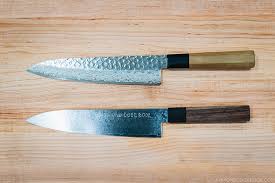Introduction:
Japanese Kitchen Knives are recognized for his or her sharpness. But there is much more to them than just that—there are several various kinds of rotor blades, metallic compositions, and take care of supplies accessible on the planet of Japanese Kitchen Knives. For people who aren’t acquainted with these knives, understanding what collections them away from each other could be a bit mind-boggling. That is why we’ve come up with this guide on choosing the best Japanese kitchen knife for your needs.
Forms of Rotor blades
The most typical type of blade employed in Japanese Kitchen knife (couteau) is the single-bevel benefit. Which means that one area in the blade is sharpened while the other continues to be level and unsharpened. One-bevel ends are well-known since they enable exact reducing and chopping but demand far more repeated honing because of their fine mother nature. Twice-beveled corners, that are sharpened on both aspects, are also available and may be easier to sustain than the usual one-bevel side as time passes.
Metallic Composition
Japanese Kitchen Knives come in a number of metal compositions, from gentler stainless steel alloys to more difficult carbon dioxide steels. Each kind has its own pros and cons for the way it will probably be used and maintained from the user. For example, smoother stainless steel alloys are a lot less at risk of oxidation or rust but might need a lot more repeated sharpening if they are used frequently while tougher co2 steels may carry a position longer but could rust otherwise properly looked after. It’s vital that you get to know various types of precious metals before you make a acquiring selection to help you find one that suits you very best.
Deal with Supplies
The deal with materials is likewise an essential concern when deciding on a knife—it should feel safe with your palm and offer enough grasp to ensure that it doesn’t move when you’re making use of it. Conventional Japanese deals with are made of wooden like rosewood or ebony nevertheless, in addition there are available options in aluminum or plastic material for many who favor anything significantly less conventional but still tough enough for every day use.
Conclusion:
With so various sorts of cutting blades, metal compositions, and manage supplies accessible on earth of Japanese Kitchen Knives, it can be tough to find the best one for you—but it doesn’t have to be! By familiarizing yourself with every type’s positives and negatives you’ll be capable of choose a knife that meets your requirements perfectly in order to begin savoring specific slices every time you make! Whether or not you’re searching for some thing conventional or present day, using this type of guideline you’ll manage to find exactly what you require!
